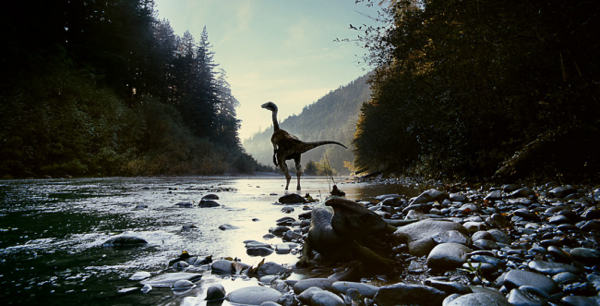Movie review by Greg Carlson
“The Tree of Life,” Terrence Malick’s nearly four-decades gestating cinematic poem, bears much fruit for admirers of the director’s (by turns) meditative, solemn, inscrutable, and prismatic approach to the craft of moviemaking as religious devotion. A two-hour and twenty minute skyscraper of thoughts, dreams, visions, and questions with no answers, the film is an achievement of mad-scientist ambition that will perplex and confound its most ardent supporters and its most vituperative detractors. Impossible for cinephiles to ignore, the Palme d’Or winner is surely the film of the year (or film for the ages?), despite – or perhaps, in part, because of – the widespread reports of mid-screening walkouts and refund demands.
Comparisons between “The Tree of Life” and “2001: A Space Odyssey” are as inevitable as they are apt, given Malick’s recruitment of long-retired Kubrick collaborator/special effects guru Douglas Trumbull and the shared contemplation of the metaphysical preoccupying both movies. Consider the following quotation: “…a film in which infinite care, intelligence, patience, imagination and Cinerama have been devoted to what looks like the apotheosis of the fantasy of a precocious, early nineteen-fifties city boy.”
Or this one: “The movie is so completely absorbed in its own problems, its use of color and space, its fanatical devotion to science-fiction detail, that it is somewhere between hypnotic and immensely boring.”
And finally: “…unreconciled plot lines… are simply left there like a Rorschach, with murky implications of theology.”
All three of the preceding notes belong to Renata Adler’s April 4, 1968 “New York Times” review of “2001,” but could as readily be applied by several current writers to “The Tree of Life,” especially if one substitutes “IMAX resolution” for “Cinerama” and “Texas boy” for “city boy” in the first sentence. Time will tell if “The Tree of Life” deserves to touch shoulders with Kubrick’s “epic drama of adventure and exploration,” and whether it will be as discussed as passionately forty years from now, but I for one am ready to take that bet.
Like the film’s pretty one-sheet, “The Tree of Life” presents a mosaic of images, many of which pivot around Malick’s structural design suggesting “two ways through life: the way of nature and the way of grace.” Most reviewers and many viewers will come to terms with “The Tree of Life” by suggesting there are two ways through the movie: the way of patience-testing frustration and the way of awestruck appreciation of one artist’s singular self-expression.
While mainstream critical response leans heavily toward the positive, Robert Koehler’s must-read “Film Journey” essay lays out a strongly argued and well-reasoned dismantling of “The Tree of Life.” Koehler spends considerable energy deconstructing the “cosmic creation” sequence, and also attacks what he sees as weaknesses in Malick’s “naïve romanticism,” “bullet point dialogue” and complete misunderstanding and application of the nature vs. grace dialectic that the filmmaker uses to distinguish Mr. O’Brien’s (Brad Pitt) fierce and willful disciplinarian from Mrs. O’Brien’s (Jessica Chastain) permissive and tenderhearted soul.
Koehler’s claims that Malick doesn’t know his vocabulary are misleading and unfair, particularly because the director is under no obligation to adhere to traditional applications of terms as broad as “nature” and “grace,” which individually claim dozens of definitions and synonyms. Additionally, the brief nature/grace speech, heard in voiceover and understood to be the words of Mrs. O’Brien to her son or sons, is filtered through the perception of the young Jack O’Brien (Hunter McKracken), whose subjective interpretation of his parents’ behavior never contradicts Malick’s symbolic Old Testament/New Testament dichotomy.
Koehler and the others who hated the surprise inclusion of several dinosaurs in the creation sequence mistakenly assume deliberate anthropomorphism in Malick’s Cretaceous Period shots, notably one moment in which a natural predator passes on an easy kill. Koehler sees it as “the birth of love, or, at least, pity,” but my own reading was exactly the opposite. Keith Uhlich, whose “The Space Between Spaces” is one of five essays on “The Tree of Life” in “Reverse Shot,” also disagrees with Koehler, and persuasively claims that any “flicker of humanity” we might see in the dinosaur is “our own projection,” and that to “gaze at instinct is to stare into the void, and not just the one evoked by the film’s opening epigraph from the Book of Job.”
Along the same thread of what Uhlich calls “narrative through reverie,” Mike Flanagan argues that “complaints about [“The Tree of Life”] lacking a standard plot structure are more about the expectations of the viewer, not a fault of the film” and therein lies the heart of the movie’s stubborn resistance to those who see failure or deficiency in Malick’s abandonment of typical cinematic syntax – including the movie’s non-chronological organization, its unorthodox rhythm and pace, and its exclusion of developed and sustained exchanges of dialogue that “drive” toward an objective. “The Tree of Life” is not for everyone, but it should be. Some will snooze, some will leave, and the rest of us will stare up at the screen, electrified and transported.
